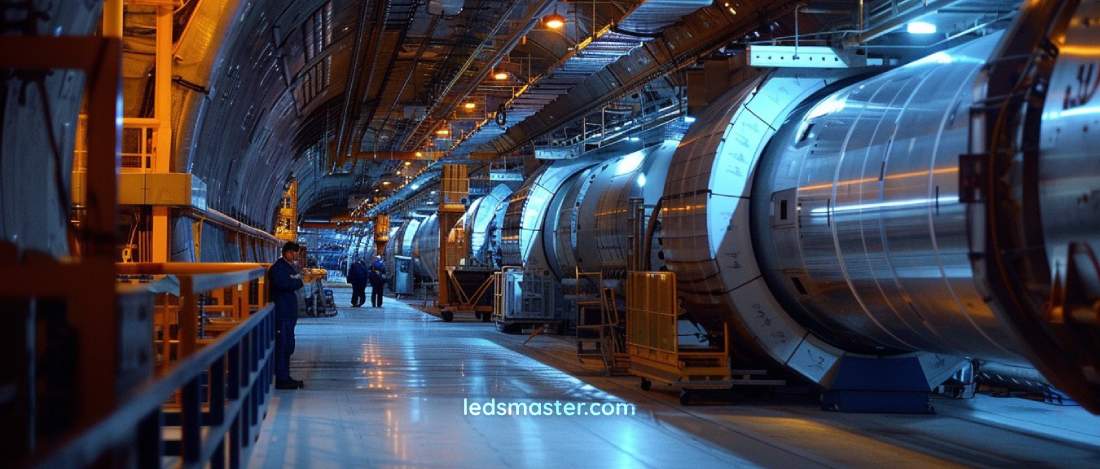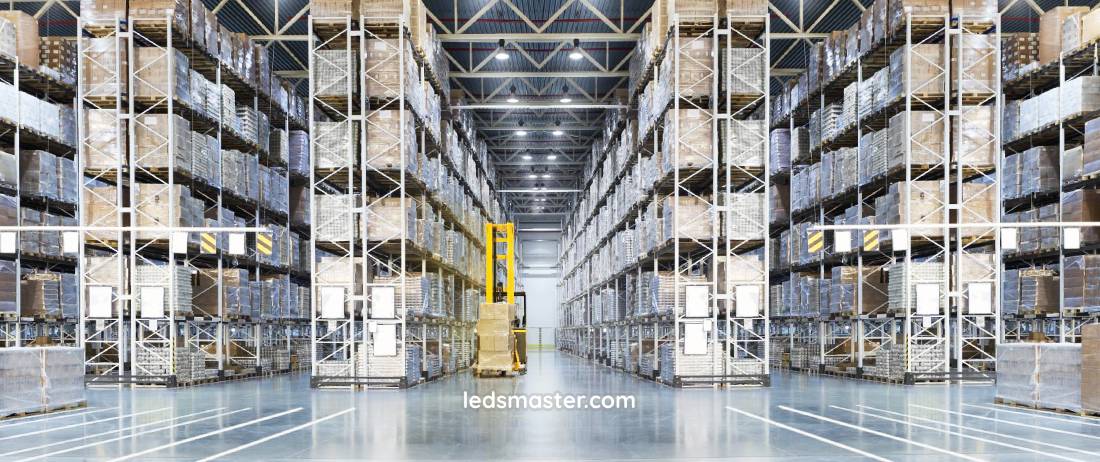High bay lighting is essential for illuminating large indoor spaces with high ceilings, such as warehouses and industrial facilities, ensuring optimal visibility and safety. Advanced LED technology enhances energy efficiency and longevity, making high bay lighting a reliable choice for enhancing productivity in demanding environments.
As warehouses, manufacturing facilities, and sports arenas continue to evolve, the demand for efficient and effective lighting solutions has never been greater. High bay lights are specifically designed to illuminate spaces with high ceilings, providing bright, uniform light that caters to the unique requirements of these expansive areas. With advancements in technology, particularly the rise of LED lighting, these fixtures now offer significant energy savings, durability, and longevity.
Get your complimentary lighting design today
Table of Contents
ToggleThe design of high bay lighting fixtures focuses on both durability and performance. These lights are engineered to endure the rigorous demands of industrial settings while providing optimal illumination. LED technology has emerged as the preferred choice in the market, primarily due to its energy efficiency, long operational lifespan, and capacity to deliver high-quality light. LED high bay fixtures are designed to be compact yet powerful, ensuring they can provide bright and uniform illumination even in expansive areas while minimizing energy consumption and maintenance costs. These fixtures are constructed to withstand the harsh conditions frequently encountered in industrial environments, such as fluctuating temperatures and exposure to dust and moisture. This reliability makes them a favored option for long-term lighting solutions in warehouses, manufacturing plants, and sports facilities.

The evolution of lighting technology has seen a marked shift from traditional incandescent and fluorescent lamps to more advanced options like LEDs. This transformation has been driven by the need for improved energy efficiency and environmental sustainability. High bay lighting, in particular, has benefited greatly from these advancements. The introduction of LED high bay lights has allowed facilities to reduce energy consumption drastically while enhancing light quality.
Energy-efficient lighting solutions not only contribute to lower utility bills but also support sustainability goals. Many organizations are increasingly aware of their environmental impact and seek to implement strategies that reduce energy consumption. By choosing LED high bay lights, businesses can play a part in reducing their carbon footprint while enjoying the advantages of modern lighting technology.
High bay lighting options encompass various technologies, including LED, metal halide, and induction lights, each featuring distinct characteristics and applications. LED high bay fixtures are gaining popularity due to their superior energy efficiency and extended lifespan compared to traditional metal halide lights. Metal halide lights are known for their initial brightness but often come with drawbacks such as longer warm-up times and higher energy consumption. This contrast highlights the advantages of LED lighting, especially for facilities aiming to optimize energy use.
Metal halide lights have been a staple in high bay lighting for decades. They produce bright, white light that can effectively illuminate large areas. However, they require a warm-up period to reach full brightness, which can be inconvenient in environments where instant lighting is necessary. Additionally, the energy consumption associated with metal halide lamps tends to be higher, leading to increased operating costs over time.
Induction lighting offers a middle ground between the efficiency of LEDs and the brightness of metal halide. These fixtures utilize electromagnetic fields to generate light, resulting in a longer lifespan than traditional fluorescent lamps. Induction lights can be beneficial in specific applications where color rendering and maintenance requirements are less demanding. While they are not as commonly used as LEDs, they still serve valuable roles in certain lighting scenarios.
High bay lighting is specifically designed for spaces with elevated ceilings, such as warehouses, manufacturing facilities, and sports arenas. These environments require adequate brightness and uniform light distribution to ensure safety and productivity. LED high bay lights excel in these applications, offering focused, directional light that minimizes glare while maximizing visibility across expansive areas. This capability is crucial for reducing shadows and maintaining consistent lighting levels throughout the space.
The significance of proper lighting in workplace safety cannot be overstated. In environments such as warehouses and factories, poor visibility can lead to accidents and injuries. High bay lighting systems that provide uniform light distribution play a vital role in ensuring that employees can work safely and efficiently. By illuminating areas adequately, these fixtures help prevent accidents and promote a safer working environment.
In addition to safety, adequate lighting contributes to increased productivity. When workers can see their tasks clearly, they can perform more efficiently and with greater accuracy. High bay lighting that minimizes shadows and provides consistent brightness enhances overall operational efficiency, allowing businesses to maximize their output.
Achieving uniform light distribution in high bay applications is a central goal to maintain visual comfort and operational efficiency. Modern high bay fixtures are equipped with advanced optics that optimize light distribution, directing illumination precisely where it is needed. This feature enhances visibility and reduces energy wastage by minimizing light spillage. By ensuring efficient use of lumens, facilities can achieve better lighting outcomes without unnecessary energy expenditure.

The design of high bay lights often incorporates advanced optical systems that enable precise control over light distribution. These optics help to minimize glare, making it easier for workers to perform tasks without straining their eyes. Additionally, they can help focus light on specific areas, reducing the amount of energy lost to undesired illumination.
When planning the layout of high bay lighting, several factors must be taken into account. The arrangement of fixtures should consider the specific tasks being performed in the space, as well as the height of the ceiling and the overall dimensions of the area. A well-designed lighting layout maximizes efficiency and ensures that all areas receive adequate illumination.
LED high bay lights are widely recognized for their exceptional energy efficiency, often utilizing up to 70% less energy than traditional lighting technologies, such as metal halide. This remarkable efficiency translates into significant cost savings over the lifespan of the fixtures, resulting in lower electricity bills and reduced maintenance expenses. The longer operational life of LED fixtures means fewer lamp replacements, further contributing to overall savings. Choosing LED high bay lights supports facilities in achieving sustainability objectives while simultaneously improving lighting quality and reliability.
The financial advantages of LED high bay lighting extend beyond immediate energy savings. Facilities can experience lower maintenance costs due to the reduced frequency of lamp replacements and repairs. This translates to less downtime and disruption in operations, allowing businesses to focus on productivity rather than managing lighting issues.
The shift towards energy-efficient lighting solutions aligns with broader sustainability goals in various industries. By adopting LED high bay lighting, organizations can significantly reduce their carbon footprint, making strides towards environmental responsibility. This shift not only benefits the planet but also enhances the reputation of businesses committed to sustainable practices.
In industrial and warehouse environments, where lighting fixtures are subjected to vibrations, dust, and fluctuating temperatures, durability is a primary concern. LED high bay lights are constructed with robust materials designed to withstand these challenging conditions, ensuring reliable performance even in adverse settings. Their solid-state design, characterized by the absence of moving parts, contributes to their longevity, with many fixtures exceeding 50,000 hours of operational life without substantial degradation in light output or quality.
High bay lighting fixtures are often installed in settings where they may be exposed to various environmental challenges. As a result, manufacturers prioritize robust construction methods to ensure their products can withstand impacts, vibrations, and temperature changes. This durability not only enhances the lifespan of the fixtures but also reduces the need for frequent replacements.
Environmental conditions can significantly affect the performance of lighting fixtures. For instance, exposure to dust and moisture can lead to operational issues if the fixtures are not adequately protected. LED high bay lights often come with protective coatings and seals that help prevent dust accumulation and moisture intrusion, contributing to their overall reliability in industrial settings.
The color rendering index (CRI) is a critical factor in high bay lighting, especially in applications where accurate color perception is vital for tasks and safety. LED high bay lights typically offer excellent CRI values, enhancing visibility and reducing errors in environments that rely on accurate color interpretation. Selecting the appropriate color temperature, such as cool white for general visibility or daylight for detailed tasks, depends on the specific requirements of the application and user preferences.
Color temperature is a key consideration when choosing high bay lighting. Measured in Kelvin (K), color temperature describes the appearance of light emitted by a fixture. For example, cool white lights (around 4000K to 5000K) provide a bright, crisp illumination that can enhance focus and visibility in work environments. In contrast, warmer color temperatures (around 3000K) create a softer ambiance, which may be more suitable for retail spaces or areas where comfort is a priority.
The CRI is a measure of how accurately a light source displays colors compared to natural light. High CRI values indicate that colors will appear more true to life under the illumination of the fixture. In applications such as painting, textile manufacturing, or quality control, where color accuracy is vital, selecting LED high bay lights with high CRI values can make a notable difference in operational outcomes.
The installation of high bay lighting at considerable heights requires careful planning to ensure optimal fixture placement and secure mounting. LED high bay lights often come with adjustable mounting options and accessories that facilitate installation and allow for precise aiming of light. Proper installation is paramount for achieving the desired lighting effects and ensuring safety in high-ceiling environments.
Effective planning for the installation of high bay lighting involves considering the specific characteristics of the space. Factors such as ceiling height, fixture spacing, and the tasks performed in the area will influence the final design. Engaging experienced lighting professionals can help ensure that the layout is optimized for performance.
Regular maintenance of high bay lighting fixtures is essential to maintain optimal performance and extend the lifespan of the lighting system. This maintenance includes cleaning and inspecting fixtures to prevent dust buildup and ensure that all components are functioning correctly. Proper maintenance practices contribute to consistent light output, reducing the likelihood of unexpected outages and operational disruptions.
High bay lighting solutions continue to advance alongside developments in LED technology, providing enhanced energy efficiency, durability, and lighting performance for various high-ceiling applications. Whether illuminating warehouse aisles, manufacturing floors, or sports arenas, selecting the right high bay lights involves careful consideration of several factors, including ceiling height, light distribution, energy efficiency, and maintenance requirements. By prioritizing these factors, businesses can enhance lighting quality, operational efficiency, and sustainability in their facilities. As the demand for efficient and effective lighting solutions grows, high bay lighting will remain an integral component in the design and operation of modern industrial spaces.